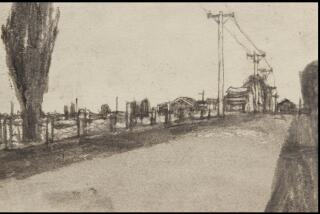From “Gonzo” (circa 1979)
“Gonzo,” a limited edition published by Ammo Books, is also an exhibition on view at M+B gallery in Los Angeles until Jan. 20
*
Like Ralph Steadman’s drawings, which illustrated Hunter S. Thompson’s prose in Rolling Stone, Thompson’s life contained a lot of splatter. Besides spilled booze, dribbled drugs and even some blood, there were lots of half-baked ideas and throwaway snapshots strewn around his Colorado compound.
Though put together by Ammo Books’ Steve Crist after Thompson’s suicide, this layout seems a good representation of his photography. Thompson wanted it to be like his writing: stream-of- consciousness or, better still, unconsciousness. There must be, he said, “no alterations in the darkroom, no cutting or cropping, no spotting . . . no editing.” It didn’t even matter who took the pictures. Two-thirds of these are of him, not by him. (This is in keeping with “Gonzo,” a form of journalism that replaces observation with self-absorption.)
The pictures of Thompson as an Arab terrorist by girlfriend Laila Nabulsi seem weirdly prescient today, but overall the impression is of a lifestyle receding into history like his convertible, “the Red Shark,” disappearing down a Nevada highway. Bill Murray, seen twice here, was soon to make a pretty good movie based on “Fear and Loathing in Las Vegas.” But the 1998 remake, produced by Nabulsi, was unwatchable. The message, as everyone who came of age in the ‘60s knows, is that you can’t go home again. Maybe Thompson’s own acceptance of that was what compelled him to shoot himself last year.
More to Read
Sign up for our Book Club newsletter
Get the latest news, events and more from the Los Angeles Times Book Club, and help us get L.A. reading and talking.
You may occasionally receive promotional content from the Los Angeles Times.






